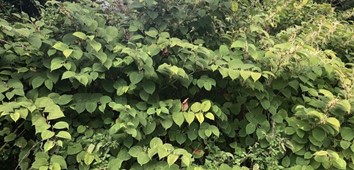Australian Plant Census (2011) available at: Vascular Plants APNI (biodiversity.org.au).
Ainsworth, N. and Weiss, J. (2002). Fallopia japonica (Houtt.) Ronse Decr. (Japanese knotweed) - An underrated threat to riparian zones in Australia. In: H. Spafford Jacob, J. Dodd and J.H. Moore (eds), 13th Australian Weeds Conference Proceedings. Plant Protection Society of Western Australia, Perth.
Anon. (2008). Japanese Knotweed Alliance.
Bailey, J.P. (2003) Japanese Knotweed aka Fallopia japonica, Reynoutria japonica and Polygonum cuspidatum.
Bailey, J.P. and Conolly, A.P. (2000). Prize-winners to pariahs - A history of Japanese Knotweed s.l. (Polygonaceae) in the British Isles. Watsonia 23: 93-110.
Baker, M. (2008). Tasmanian Herbarium, Hobart. Personal communication.
Barney, J.N., Tharayil, N., DiTommaso, A. and Bhowmik, P.C. (2006). The biology of invasive alien plants in Canada. 5. Polygonum cuspidatum Sieb & Zucc. [=Fallopia japonica (Houtt.) Ronse Decr.]. Canadian Journal of Plant Science 86: 887-905.
Beerling, D.J., Bailey, J.P. and Connolly, A.P. (1994). Fallopia japonica (Houtt.) Ronse Decraene. Journal of Ecology 82: 959-979.
Doll, J. and Doll, J. (2002). Japanese Knotweed (Polygonum cuspidatum). WeedScience, University of Wisconsin.
Gillespie, P. and Faithfull, I. (2004). Knotweed: State Prohibited Weed. Landcare Notes LC0377. Department of Primary Industries, Frankston, Victoria.
Hansford, M. (2008). Department of Primary Industries, Box Hill, Victoria. Personal communication.
Hollingsworth, M.L. and Bailey, J.P. (2000). Hybridisation and clonal diversity in some introduced Fallopia species (Polygonaceae). Watsonia 23: 111-121.
Hosking, J.R. (1997). Appendix 1 - Checklist of the introduced taxa naturalised in Australia 1971-1995, in R.H. Groves (convenor), Recent Incursions of Weeds to Australia 1971-1995. Technical Series No. 3. CRC for Weed Management Systems, Waite Campus, University of Adelaide.
Lane, D. (2008). Department of Primary Industries and Water, Prospect, Tasmania. Personal communication.
Navie S. (2004). Declared Plants of Australia. An identification and information system. Centre for Biological Information Technology: Brisbane. [CD-ROM]
Spencer, R. (ed.) (1997). Horticultural Flora of South-eastern Australia. Flowering Plants. Dicotyledons, Part 1. University of New South Wales Press, Sydney.
Tasmanian Department of Primary Industries and Water (2007). Weeds, Pests and Diseases - Japanese knotweed - Statutory Weed Management Plan. Fallopia japonica (Japanese knotweed). Available (updated) at: Japanese-knotweed_WMP_2011.pdf (nre.tas.gov.au) [pdf link]
Thurlow Countryside Management (2008). UK Invasive Weeds.
Wilson, K.L. (2000). Polygonaceae, in G.J. Harden (ed.), Flora of New South Wales Volume 1, revised edn pp. 278-293. University of New South Wales Press, Sydney (as Reynoutria japonica). Available on New South Wales FloraOnline at: PlantNET - FloraOnline (nsw.gov.au)
Wilson, K.L. (2008). National Herbarium of New South Wales, Royal Botanic Gardens, Sydney. Personal communication.
Wilson, L.M. (2007). Key to Identification of Invasive Knotweeds in British Columbia. British Columbia Ministry of Forests and Range, Forest Practices Branch, Kamloops, British Columbia.
Weeds of Australia (2016). Fallopia japonica fact sheet. Available at: Fallopia japonica (lucidcentral.org)
































